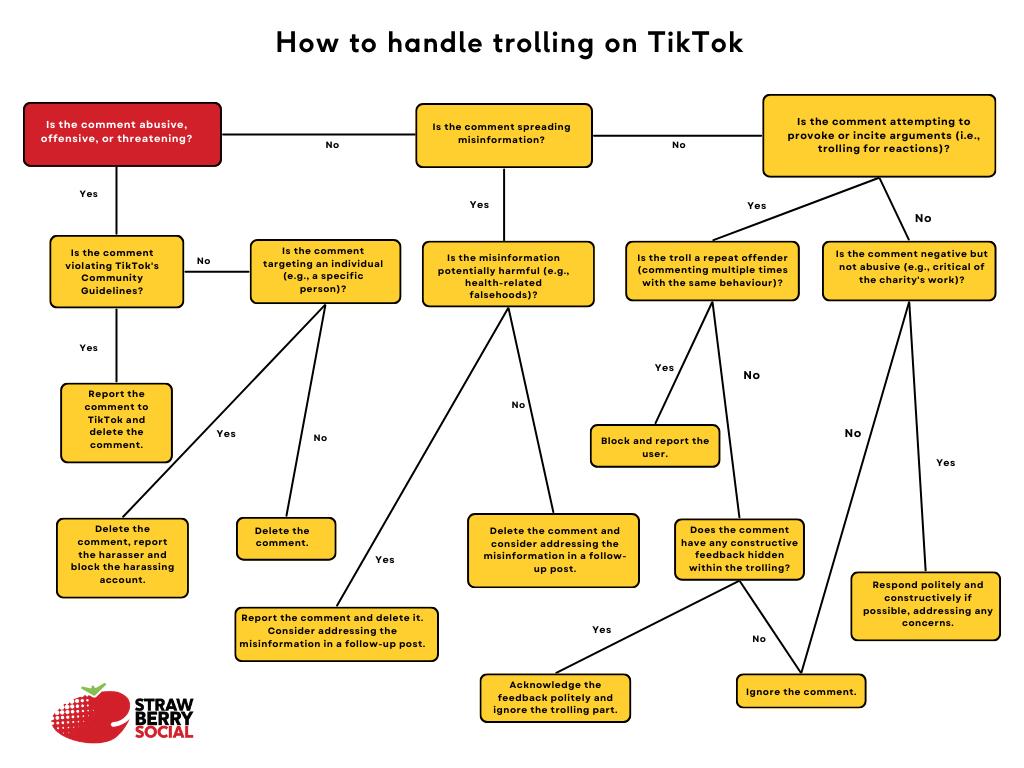How to share your volunteering experience (without sounding like you’re bragging)
Top tips for sharing your volunteering experience loud and proud
Posted 4 June 2025

With help from the team at StrawberrySocial, discover how your charity can thrive on TikTok with expert tips on ensuring online safety, managing trolls, and fostering genuine engagement. Protect your community and amplify your mission effectively.
With over 150 million monthly active users in Europe, the majority aged 18-34, TikTok offers tremendous opportunities for charities to achieve reach and authentic engagement, particularly with younger audiences. In this guide, we will cover the steps you can take to keep your audience safe and share simple strategies to manage negativity and trolling behaviour on TikTok.
StrawberrySocial is a social media moderation agency specialising in brand protection, online safety and community engagement for charities. Our team of experts have the knowledge and skills to protect, moderate and engage with online audiences 24/7/365. We are proud to work with leading brands and charities including NHS England, NSPCC, RNIB, Just Eat, SuperAwesome, Which? and Samaritans.
Common types of negative interactions on TikTok include trolling, cyberbullying, scams, and spam.
For charities especially, these negative interactions can lead to reputational damage and a loss of trust, impact fundraising efforts and ultimately undermine the charity’s mission. Persistent online harassment can also demoralise staff and volunteers, reduce engagement and create a toxic environment for users.
Content that can attract trolls includes controversial topics, political discussions, personal opinions, sensitive issues such as race, gender, and religion, and posts that showcase personal achievements or vulnerabilities.
On a platform like TikTok, younger audiences appreciate and seek out authenticity, intersectionality and representation, so, if your charity seeks to truly connect with them, it is almost impossible to avoid trolls by avoiding these content types altogether.
Actively engaging with your audience and using language that promotes respectful discourse can help mitigate the impact of trolls and negative comments. Encouraging constructive feedback and highlighting positive contributions can also help to shift the focus away from negativity. Actively reward or promote positive and worthwhile comments/UGC.
Stitching and dueting public content is a wonderful way to get your community engaged and sharing your mission. But it does come with a downside. Anyone can stitch or duet your content if your account is set to public and your privacy settings are set to ‘Everyone’.
You won’t be able to stop every stitch or duet, but schedule in some time to do quick hashtag searches for possible problems. If it becomes a bigger problem you can always delete all duets and/or stitches from a video’s privacy settings.
A tactic often employed by scammers is to recreate the public username of a charity in order to send DMs from these accounts to followers. These scammers will ask users to go to another platform (such as Telegram) to speak directly, or to donate.
Schedule in regular spot-checks for impersonation accounts and report to TikTok. In addition, your channel information should include notes for your followers so that they will be able to identify potential scammers trying to impersonate your official page. Encourage your followers to report them too.
Prepare guidelines on when and how to respond to negative comments constructively, when to delete, and when to report and block a user. For example:
We’ve created a decision tree to help you.

For a screen reader friendly decision tree, refer to the download button at the bottom of the article.
This decision tree can be printed and kept handy to help quickly determine the best course of action to take for trolling behaviours.
Your social media and community management team can be regularly exposed to graphic imagery, challenging content and negativity, especially those on the front lines of content moderation. It’s important to acknowledge this and to have internal processes in place to support them.
A number of charities and other organisations are notable in their ability to tackle trolls swiftly and effectively.
RNIB responds to a variety of negative comments calmly, openly and clearly in a respectful manner.

WeRateDogs answer a complainer’s concern in a tongue-in-cheek manner in line with their whimsical tone and important mission.

British Red Cross responds to trolls with humour and dance moves.

Ultimately, effective moderation and clear engagement are essential for charities aiming to build and maintain a safe, positive and supportive environment on TikTok. Establishing clear community guidelines, promoting positive interactions, making use of moderation tools, learning from others and fostering a culture of respect and inclusion will all help to build trust and authentic engagement with your audience. We hope you found this practical guide to TikTok moderation and online safety for charities helpful.
StrawberrySocial supports charities with content moderation, community management and social media engagement. If you’d like to access more social media and online safety tips and trends, you can sign up to the StrawberrySocial SMOSLetter here.
Further reading and resources:
Top tips for sharing your volunteering experience loud and proud
Posted 4 June 2025

How to show your volunteers appreciation and keep them involved
Posted 3 June 2025

Struggling to communicate your charity’s impact clearly? This beginner's guide will help you build a strong Theory of Change
Posted 14 May 2025
